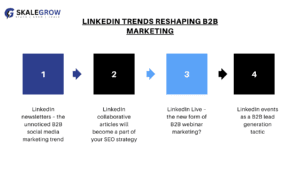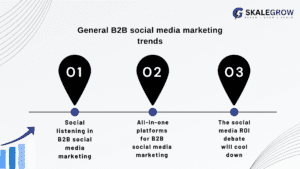This is the second of a series of articles that cover the top B2B marketing trends to watch out for in 2024. For better context, I recommend you give the first article in the series on the topic of top B2B content marketing and SEO trends to watch out for in 2024 a read.
While the early 2010s saw many B2B companies experimenting with different social media platforms, the late 2010s and early 2020s have been about focusing on a few and making them work. With B2B marketers realizing the impact of ‘dark social’, there has been an increased inclination towards social media as an effective demand generation channel.
In this blog post, we look at some of the top B2B social media marketing trends that are reimagining the way we approach social media marketing in the B2B world.
LinkedIn – the best B2B social media marketing platform?
LinkedIn remains the best social media platform for B2B businesses in 2023 and is likely to remain so at least till the first half of this decade. According to Sprout Social, LinkedIn is rated as the most effective channel for driving high-quality leads by 40% of B2B marketers.
So clearly, it seems as though LinkedIn is getting its game right. For this reason, a lot of the trends we discuss today will be related to LinkedIn.
Related: How To Create Content For LinkedIn Organic Marketing [With 10+ Examples And 5 Templates]
What are the other B2B social media marketing platforms?
Many have experimented with Facebook and Instagram for B2B marketing and selling. But most B2B businesses don’t find them useful as a demand and lead generation channel (they can be good for employer branding though). There are always exceptions to the rule. In general, Facebook and Instagram are not made for a B2B audience.
Some are also experimenting with TikTok. Though it’s quite early to give any verdict on the platform in terms of B2B social media marketing effectiveness, TikTok doesn’t seem to be making a buzz among B2B marketers.
So what are we left with? Mostly YouTube.
But is YouTube really a social media platform? In my personal opinion, it’s not. At the same time, many consider it to be one. Hence, we will also touch upon a few YouTube trends that are likely to define B2B marketing in 2024 and beyond.
B2B social media marketing trends for 2024
We will divide the trends into 3 sections:
- LinkedIn trends – this covers LinkedIn-specific trends
- YouTube trends – this touches upon a few YouTube trends for B2B.
- General B2B social media marketing trends – anything that concerns B2B social media marketing in general and doesn’t fall under the above two categories will be covered here.
Let’s go.
LinkedIn trends reshaping B2B marketing
According to Sprout Social, 3 new members sign up on LinkedIn every second. That shows massive growth. If you haven’t already, this is the time to start your LinkedIn marketing efforts – especially organic. And understanding the trends well and crafting your marketing strategy around that is important.

LinkedIn trends reshaping B2B marketing
1. LinkedIn newsletters – the unnoticed B2B social media marketing trend
According to Social Media Today, as of Aug 23, 2023, LinkedIn has facilitated over 365 million total newsletter subscriptions, while newsletter readership has tripled over the past year, and is now exceeding 1.3 million daily readers in the app.
We see more and more B2B businesses venturing into LinkedIn newsletters. It acts as an additional distribution channel without having to put in much incremental effort (if you are repurposing your existing content). This is also one of the reasons why I repost the articles published on Skalegrow’s website on my LinkedIn newsletter Elevate Your Marketing.
Now, here is a surprising fact when it comes to LinkedIn newsletters that most don’t know about. If you already have a decent following on LinkedIn, getting subscribers with your first edition is easy since an automated notification goes out to all followers once you publish it. Roughly 5 to 10% of your followers will accept the invitation.
We discussed this hack in one of Skalegrow’s newsletter editions. Check it out here.
In essence, a LinkedIn newsletter is an opportunity for you to quickly establish a new channel for content distribution. The only caveat here is that you need the creator permission on the platform. So if your company handle doesn’t have it, try using your founders’ or senior leaders’ profiles to publish newsletter content.
2. LinkedIn collaborative articles will become a part of your SEO strategy
Many of you know about LinkedIn collaborative articles already where you are asked to share your thoughts on a question. LinkedIn offers users top voice badges once they exceed a specific number of contributions.
This has led to increased participation from those who want to build a personal brand on the platform. But did you know that this plan is part of LinkedIn’s masterful SEO strategy?
Think about it. LinkedIn is using its user base to get content created for free. This content is also indexed on search engines. This in turn means free organic traffic without investing a penny in in-house content creation. It is also a great example of user-generated content.
The majority of businesses do not see this as a part of their SEO strategy. But this will be a powerful tactic to include in your marketing weaponry, especially for early-stage businesses that don’t have much online presence yet.
The key challenge here is that this requires active contribution from your employees who are willing to put in that extra effort to create content for collaborative articles. In addition, at the moment, contributing to collaborative articles is only possible through an automated invitation system on LinkedIn. Typically, you get an opportunity only if you are an active content creator on the platform.
3. LinkedIn Live – the new form of B2B webinar marketing?
Webinars have been there in the B2B world for ages. But LinkedIn Live offers a more interactive and on-platform experience for its users to get educated on topics they are interested in. Unlike a normal webinar, attendees don’t have to share their email ID to attend the live session.
Another key advantage is that the content of the session appears on the LinkedIn feed like a usual post, which gives an extra push to the content. I see more and more B2B companies experimenting with LinkedIn Live, especially savvy startups that are the first to jump onto something new.
But here’s an interesting prediction about LinkedIn Live. Currently, if you want to host a LinkedIn Live session, you need to use a video streaming solution like Zoom, Restream, or StreamYard.
However, it is highly likely for LinkedIn to introduce a native video streaming solution (just like how it killed post scheduling tools by introducing the feature within the platform itself). This is a bold prediction. Let’s wait and see if this becomes a reality.
Related: Webinar Marketing – Everything You Need To Know
4. LinkedIn events as a B2B lead generation tactic
One of the ways in which SDRs (Sales Development Representatives) and lead generation specialists leverage LinkedIn is by attending events that their ICP is likely to attend. By RSVPing for an event on LinkedIn, you get permission to directly message another attendee without being connected with him/her. SDRs use this as a method to expand their outreach activities beyond the limited connection requests and InMail credits they get with the free or paid plan of the platform.
This technique is not yet very popular among many companies. Most early-stage B2B companies don’t even know about this. 2024 will see higher adoption of this tactic, particularly because paid marketing activities are being trimmed down owing to the economic downturn and subsequent budget cuts.
YouTube trends for the modern B2B social media marketing era
The creator economy is booming. We all have read about how YouTube is incentivizing creators to do more on the platform. But what are some of the key trends that B2B businesses should take note of? Let’s explore in this section.

YouTube trends for the modern B2B social media marketing era
1. YouTube shorts are also for B2B
Shorts are becoming big on YouTube. We see major B2B brands like HubSpot and Salesforce creating shorts. The major names are already on the trendwheel. If you have not started creating shorts yet, this is the time.
But what if you don’t have enough budget to have a professional video production setup? Maybe you don’t have an in-house video editor. Can you still do video marketing in such a case?
The answer is YES.
Whether it’s for shorts or long-form videos, you don’t have to necessarily shoot videos to do video marketing. You can apply lean video marketing techniques to keep costs down while consistently creating videos to be promoted across channels.
To learn more about how to implement lean video marketing for your B2B business, visit the below article:
Lean B2B Video Marketing – Strategies And Approaches
2. Collaborations are the next big thing in YouTube marketing
In the B2C, FMCG, and D2C sectors, we have seen many brands collaborating with individual creators to promote their products. That’s influencer marketing. This has now made its way into the B2B world too where founders and B2B marketing leaders co-create content with people in their ICP. Webinars, LinkedIn Lives, and podcasts are the most common forms of co-created content types in this regard.
This is how it works.
As a part of your marketing efforts, you might want to conduct webinars, panel discussions, and podcasts. All of them need guests who are experts in their respective domains. Instead of looking elsewhere, why not find them from your ICP? This way, you build an organic relationship with your ideal customers. They are automatically warmed up as they co-create content with you. Your brand will always be in the back of their mind when they are ready to buy.
I discussed this tactic in my article on B2B influencer marketing. Linking it here for further reference:
Lean B2B Influencer Marketing: An Untapped Gem
To give you an example of such a collaboration, I recently appeared on the Gravitas WINS podcast hosted by Joseph Jude. Here is an excerpt from the podcast where I break down the steps involved in lean B2B video marketing.
3. YouTube marketing in local languages
According to Foundation, YouTube has local versions in more than 100 countries across 80+ languages covering 95% of the global population. After English, Spanish is the most popular language on YouTube. Further, as per Statista, India has the highest YouTube user base with 462 million active users.
What do these stats mean for B2B marketers?
If you as a business sell into non-English speaking countries, you have a higher likelihood of reach if your content is in the local language. This becomes more important if you are selling high-volume and low-ticket items since a major portion of your buyers is not likely to be proficient in English.
A good example of this for the Indian market is a business selling software products and solutions for schools. Since they are usually low-priced items, the only way to win is to play a volume game. And in India, not all school authorities are comfortable communicating in English formally. If you want to reach such an audience through online mediums, you need content in the local languages.
So, if you have the budget, creating content in local languages, especially in countries where the English-speaking population is very small (e.g. Japan), is an excellent way to literally and practically speak your customers’ language. We are likely to see more businesses investing resources into local video content in 2024 and beyond.
General B2B social media marketing trends
In this section, let us look at some common B2B social media marketing trends that cut across multiple platforms.

General B2B social media marketing trends
1. Social listening in B2B social media marketing
Social listening and analytics tools like Brands24, Mention, Brandwatch, Meltwater, etc., are used to identify the quantity and quality of the conversations happening around a brand on social media. While this was earlier popular only in B2C, today B2B brands are following suit.

Source: smartinsights.com
In a world where brand is everything, online community and reputation management have become paramount. Hence, keeping an eye on what is happening in social media is critical, especially for large B2B brands. The future might see a higher adoption of social listening and analytics tools. Now that AI has become mainstream, AI-based sentiment analyses are also done using social media listening tools.
2. All-in-one platforms for B2B social media marketing
We already spoke about how LinkedIn is introducing new features on the platform that might put many tools out of business (or at least lose some business). Similarly, LinkedIn is also trying to dominate the content and information space with innovative SEO tactics.
If we come to YouTube, we see the platform offering multiple types of content hosting services such as long-form videos, shorts, and even podcasts. All these indicate these platforms’ attempts to become an all-in-one platform for the content formats they are focused on.
This can be considered a part of the consolidation meta trend that is happening across industries where nobody wants to use 10 different apps for 10 tasks. Rather, they are looking for the convenience of using a few to get everything. This also makes data analysis and flow easier with a more integrated marketing ecosystem.
3. The social media ROI debate will cool down
We were in the middle of an era where social media marketers were forced to show the ROI of everything they do in dollar terms. However, this proved to be an inefficient approach since the traditional B2B revenue attribution model had major flaws.
(I discuss this in detail in the article Why B2B Revenue Attribution Is Broken And How To Fix It?)
Many B2B founders and marketers have started realizing the power of social media as a tool for spreading awareness, improving brand recall, and generating demand. Though not as predictable as some of the other channels like paid ads and email, studies show that social media marketing does have an impact on the topline of the business.
This means that fewer and fewer B2B social media marketers have to ‘convince’ the management of social media spending. The desperation to show the impact of social media in an attribution report will go down.
This is not to say that ROI analysis will not be done for social media as a channel. Rather, the traditional methods will evolve with more focus on self-reported attribution and qualitative data (like customer surveys for example).
Skalegrow – B2B social media marketing agency
Skalegrow is a B2B marketing agency aimed at making life better for marketing leaders and founders in the B2B space. It was founded to address two key challenges in the B2B world:
- The lack of quality of services offered by marketing agencies
- The misalignment of marketing activities with organizational-level goals
By introducing a consultative approach to offering marketing services, Skalegrow strives to make growth simpler and predictable for B2B companies. From LinkedIn marketing to YouTube marketing and email marketing, we offer a complete suite of marketing services to the IT, SaaS, tech, and embedded systems industries. If you are looking for help in implementing marketing tactics that work, please write to us at info@skalegrow.com.
About the author

Naseef KPO is the Founder and CEO of Skalegrow. He comes with rich experience across multiple areas of B2B marketing including content marketing, demand generation, SEO, account-based marketing, marketing analytics, revenue attribution, marketing technology, etc. He writes thought-provoking and relevant articles on The Skalegrow Blog and his weekly LinkedIn newsletter Elevate Your Marketing.
Prior to starting Skalegrow, Naseef led large marketing teams in multi-million dollar B2B organizations where he made significant contributions to the topline growth of the business. He has also appeared on numerous podcasts where he shared his thoughts on trending marketing topics such as the application of AI in marketing, startup marketing, ABM, and B2B content marketing, just to name a few. Being the founder of Skalegrow, he is currently focusing on helping its clients stay ahead of their competition by using innovative yet practical marketing tactics.
You can connect with Naseef KPO on LinkedIn.



